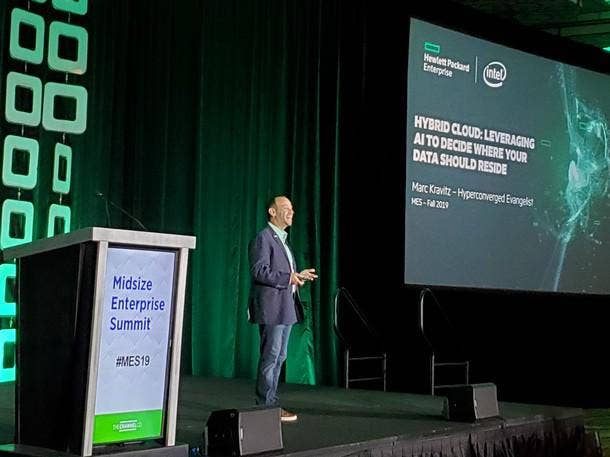5 Things To Know About HPE SimpliVity For The Midmarket
HPE’s SimpliVity hyper-converged infrastructure offering brings a number of differentiators around capabilities and consumption model, an executive told attendees at the Midsize Enterprise Summit.

There are numerous reasons why hyper-converged infrastructure is a strong fit for midmarket customers, a Hewlett Packard Enterprise executive told midmarket IT leaders Monday.
Marc Kravitz, hyper-converged category manager for HPE, spoke during The Channel Company's Midsize Enterprise Summit: Fall 2019, which is being held this week in Phoenix.
[Related: Midmarket Shifting To Digital As Quickly As Large Enterprise: Survey]
Kravitz shared why HPE's hyper-converged system, SimpliVity, is making an impact on midsize-business customers and how it's differentiated from competitors.
What follows are five things to know about HPE SimpliVity for the midmarket.
Outlook
Hyper-converged is a massive opportunity in the midmarket space, Kravitz said.
"About 50 percent of where we're seeing the activity around this space is in this midmarket and SMB," he said, citing data from market intelligence firm IDC.
"This market is growing. We’ll see $12 billion by 2022. It's not going away," Kravitz said.
That $12 billion figure includes a $2.4 billion opportunity for hyper-converged infrastructure in the midmarket, according to IDC.
"You look at a lot of the reasons—complexity of workloads, the need for automation, the need to be able to simplify what we're doing internally—and that fits extremely well with hyper-converged infrastructure," Kravitz said.
InfoSight
HPE has recently extended its InfoSight predictive analytics software, originally acquired through the Nimble acquisition, to SimpliVity.
InfoSight is "our AI engine that we use to simplify IT operations. It's self managing, self-optimizing—really using data to make better decisions," Kravitz said. "If you think of all the data that's being pumped out— trillions of data points—from all around the globe, how can we allow our customer base to utilize that so they can make better decisions going forward? So we utilize machine learning and predictive analytics to go ahead and drive this."
What that allows HPE to do is "to predict and recommend different types of decisions" with SimpliVity, he said.
"So, for example, if I'm going to migrate a virtual machine, I've done a replication project, how much bandwidth are we going to need? It can predict things, such as when capacity might be running out,” he said. “If we know that another customer is having an issue with an upgrade to new firmware, we can let our customers know around the globe, 'Don't do this right now.' These are some of the applications that we're seeing."
Workload Migrations
One of the key use cases for SimpliVity is around data migration and the ability to move "massive amounts of data very efficiently," Kravitz said.
In the midmarket, SimpliVity recently had a law firm customer that had made an acquisition and was looking to move 50 TB of data, he said.
"It seems kind of daunting, right? Probably a couple of weeks of work," Kravitz said. "What they decided to do was place a SimpliVity node at the acquisition site, and a couple SimpliVity nodes at their main site. And they were able to migrate 50 TB of data in seven hours, with only seven minutes of downtime."
Ultimately, SimpliVity is "fundamentally changing how you manage your data, how you support it, and how you're able to move it across different sites," Kravitz said.
Data Protection
HPE SimpliVity is "fanatical" about data protection, and data protection capabilities have been built into the product from the ground up, he said.
Compared to the typical approach to providing copies of production data, “what we've done is we've doubled that essentially, in that every SimpliVity cluster is going to be running two copies of production data,” Kravitz said. “So we doubled the amount of data that customers typically get from enterprise data protection."
As far as backups, "all of that is included within our products and we provide the ability to easily add backups, and restore as well," he said. "So in this instance, we've been able to double the amount of backup data that we have within our solution."
GreenLake
HPE's GreenLake pay-per-use model is another key differentiator for SimpliVity, Kravitz said.
"We think of it as taking that hybrid cloud experience, but providing it in a consumption model," he said. "There are no cash outlays for your system. So you're able to get what you need now, and only pay for what you use."
Kravitz said that traditionally, for hardware purchases such as storage, "we're going to be over-purchasing because we know at some point, we're going to need that type of capacity."
What GreenLake enables is reducing "a lot of that risk from having to overpay," he said.
In addition, "we give you a capacity buffer, meaning that if I need to go ahead and expand, I already have my capacity on site. So we've been able to increase that time to value," Kravitz said.